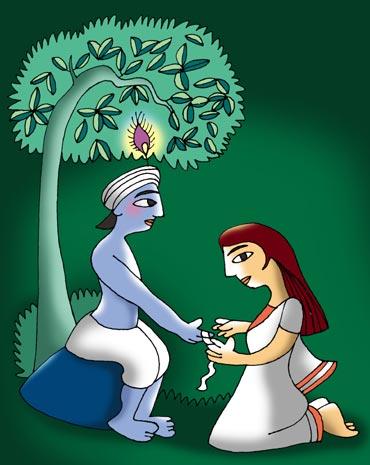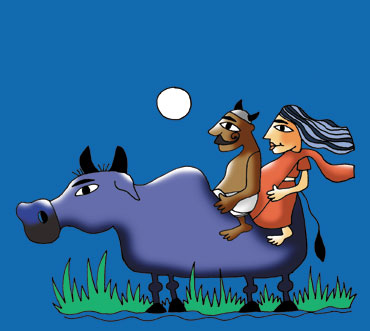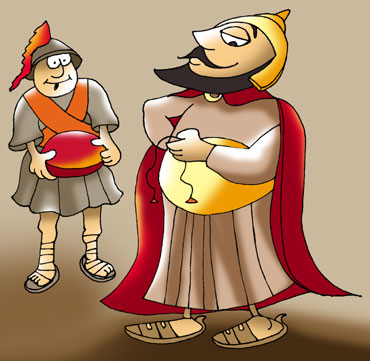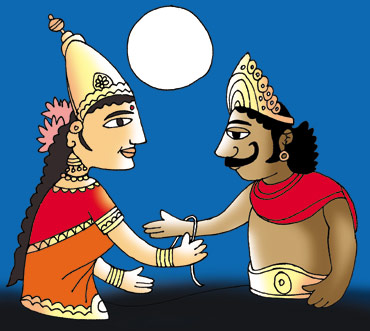Like all Indian festivals, the festival of rakhi has numerous tales associated with it. Here are some you may or may not have heard.
Everyone loves a good story and when it is about a festival it's even better, isn't it? So here they are -- stories of Raksha Bandhan from history and mythology so you can tell your kids about why we celebrate this festival.
Krishna and Draupadi
Perhaps the most popular of the rakhi stories in our mythology is that of Lord Krishna and Draupadi -- the wife of the five Pandavas.
An incident in their lives finds a mention amongst the various stories of the Mahabharata.
According to one version on a Sankranti day, Krishna managed to cut his little finger while handling sugarcane. Rukmini, his queen immediately sent her help to get a bandage cloth while Sathyabama, his other consort rushed to bring some cloth herself.
Draupadi who was watching all of this rather simply tore off a part of her sari and bandaged his finger.
In return for this deed, Krishna promised to protect her in time of distress.
The word he is said to have uttered is 'Akshyam' which was a boon: 'May it be unending'.
And that was how Draupadi's sari became endless and saved her embarrassment on the day she was disrobed in full public view in king Dritarashtra's court.
Illustrations: Uttam Ghosh
Rani Karnavati and Emperor Humayun
Image: In a time of distress Rani Karnavati reached out to Emperor Humayun for helpAmong the many tales of Raksha Bandhan, a version of the story of Rani Karnavati and Emperor Humayun is one that often finds a mention.
Karnavati was the regent of Mewar after the death of her husband Rana Sanga. She ruled in the name of her elder son Vikramjeet.
When Bahadur Shah of Gujarat attacked Mewar for the second time -- he had defeated Vikramjeet earlier -- the queen began reaching out to her nobles for support.
Initially apprehensive, the nobles finally agreed to take on Shah.
In the meanwhile, Karnavati also wrote to Humayun, for help. She sent him a rakhi and sought protection.
Interestingly, Humayun's father Babur had defeated Rana Sanga when he led a confederation of Rajput armies against him in 1527.
The Mughal emperor was in the middle of another military campaign when he received the call for help. Abandoning it he turned his attention to Mewar.
Unfortunately, he never made it on time. As the Rajput army was defeated in Chittor -- where the battle was taking place -- Karnavati committed Jauhar -- an act of self-immolation to protect herself from indignity of falling in the hands of Bahadur Shah.
Shah however could not go any further and had to turn away from Chittor as Mughal military reinforcements arrived soon after.
Humayun then restored the kingdom to Karnavati's son, Vikramjit.
Yama and the Yamuna
Image: Yama and the YamunaAccording to another legend, the ritual of Raksha Bandhan would be followed by Yama, the Lord of Death and Yamuna, the river that flows in India.
The story goes that when Yamuna tied a rakhi to Yama, the lord of death granted her immortality. And so moved he was by the gesture, he is said to have declared that any brother who was tied a rakhi and offered to protect his sister would also become immortal.
Roxana and King Porus
Image: Alexander the Great and King PorusAnother legend has it that when Alexander the Great invaded India in 326 BC, his wife, Roxana sent Porus, a sacred thread and asked him not to harm her husband on the battlefield.
Honouring the request, when he confronts Alexander, he refuses to kill him. Eventually, Porus would lose the battle of the Hydaspes River but would gain Alexander's respect and honour.
Eventually, after his death, Porus would become a very loyal Macedonian satrap.
The birth of Santoshi Maa
Image: Ganesha and his sister ManasaNow even though this tale has no basis in the Hindu scriptures, the take of the birth of Santoshi Maa has been linked to the festival of Raksha Bandhan.
Popularised by the 1975 Bollywood film Jai Santoshi Maa, the tale goes somewhat like this:
On the auspicious day, Lord Ganesha's sister Manasa visits him to tie him the rakhi. On seeing this, Ganesha's sons -- Shubha and Labha -- begin insisting on having a sister.
Giving in to their demands, Ganesha creates goddess Santoshi from the divine flames that are said to have emerged from his consorts -- Riddhi and Siddhi.
Goddess Laxmi and King Bali
Image: Goddess Laxmi and King BaliUnlike the previous one, this legend does find mention in various Hindu scriptures.
A version of this story goes thus:
As part of a promise, Lord Vishnu has been protecting his devotee and the demon King Bali, disguising himself as his doorman.
Back in Vaikunth, the abode of Vishnu, his consort Laxmi has been missing him.
Disguising herself as a woman seeking a shelter to live in since her husband has been away, she approaches Bali. The generous king opens the doors of his palaces for the lady.
As Laxmi, the goddess of wealth and prosperity enters the household Bali begins to prosper.
On the full moon day of in the holy month of Shravana, Laxmi ties a thread of coloured cotton on Bali's wrist and wishes for protection and happiness.
Bali asks her what she desires and promises to fulfil it.
Laxmi simply points to the gatekeeper who now reveals his real identity. The goddess follows suit.
Bali keeps his promise and requests Vishnu to return to his home with his consort. In return, Vishnu promises to return and be with Bali for four months of each year.







Comment
article